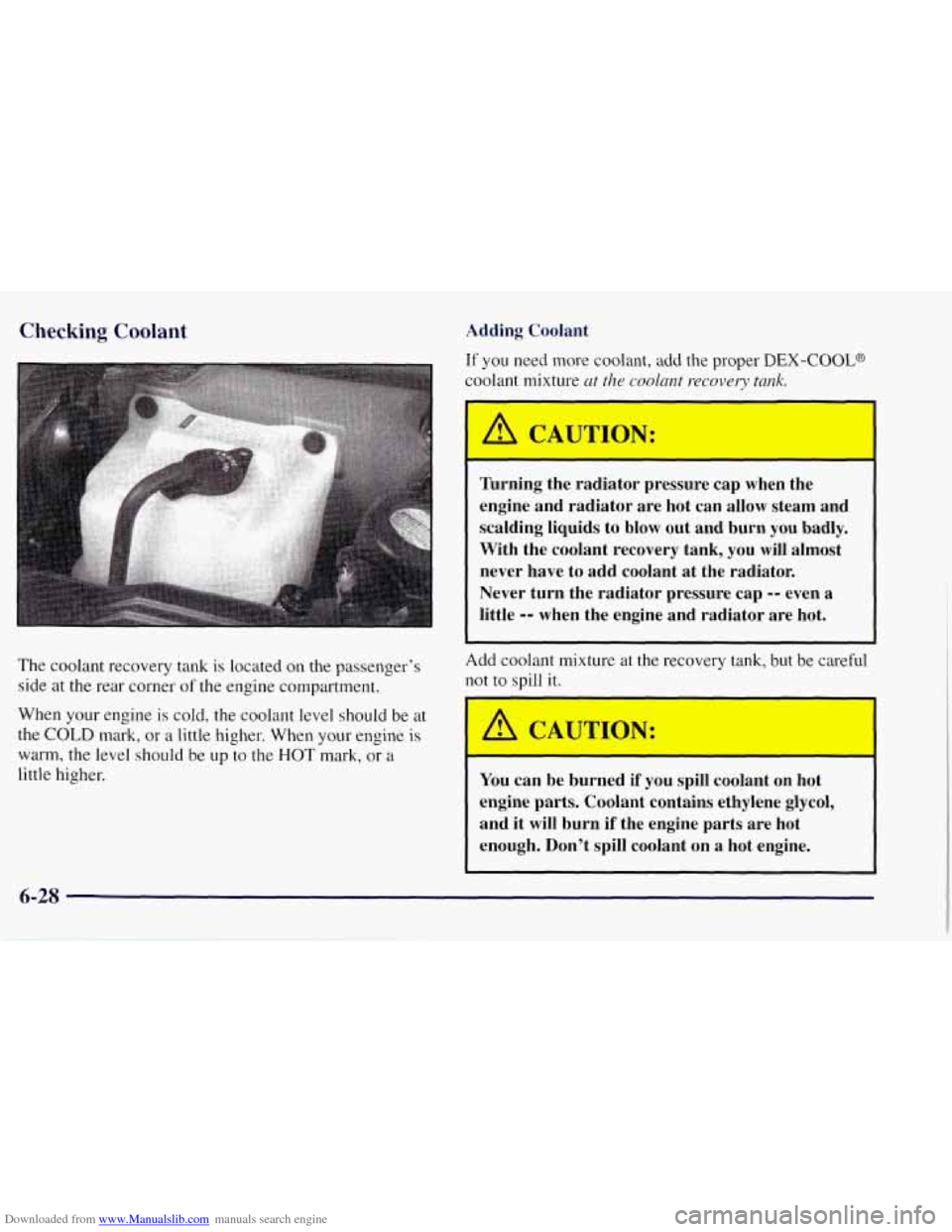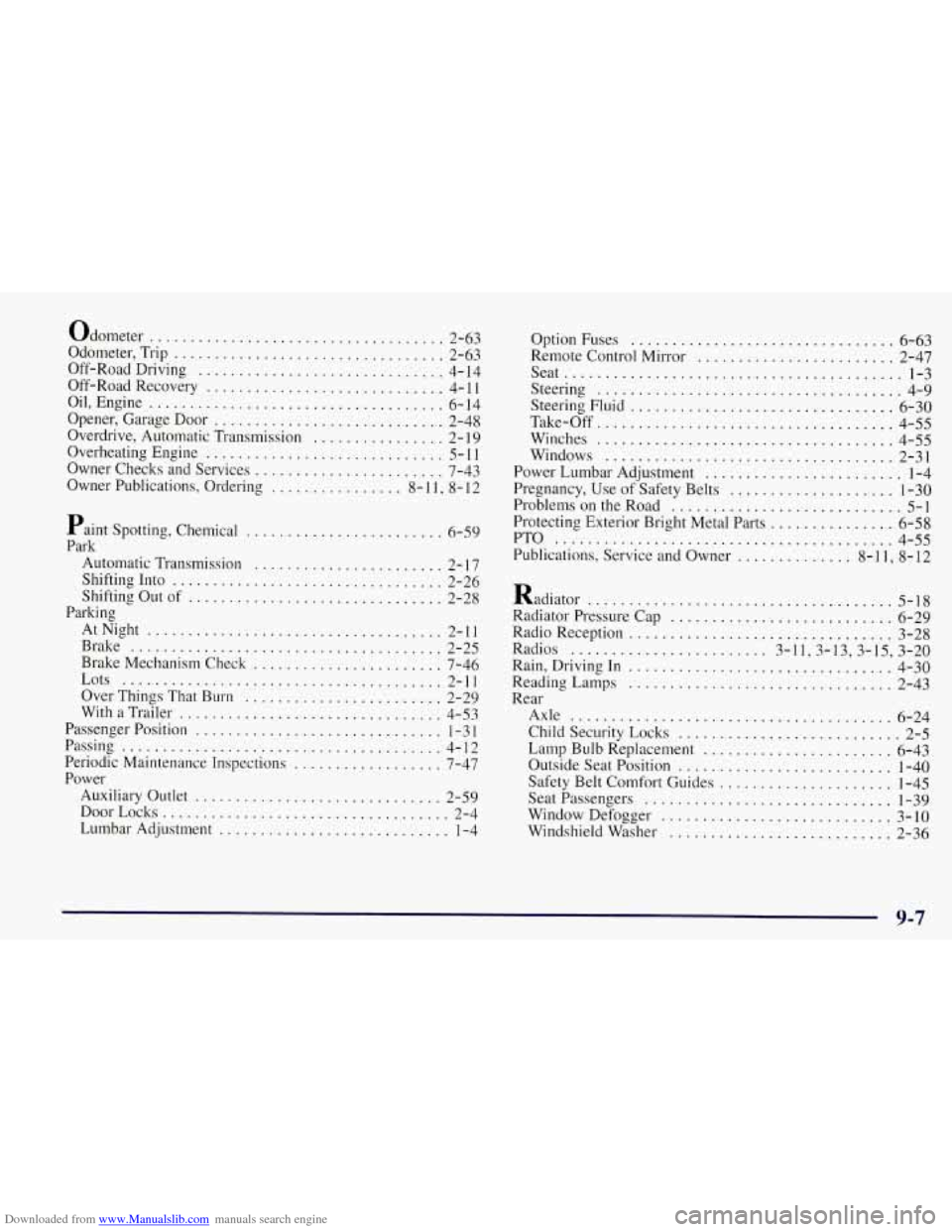Page 294 of 433

Downloaded from www.Manualslib.com manuals search engine When to Add Oil
If the oil is at or below the ADD mark, then you’ll need
to add at least one quart of oil. But you must use the
right kind. This part explains what kind
of oil to use. For
crankcase capacity, see “Capacities and Specifications”
in the Index.
NOTICE:
Don’t add too much oil. If your engine has so
much oil that the oil level gets above the upper
mark that
shows the proper operating range,
your engine could be damaged.
The engine oil fill cap on the “VORTEC” 5700 is
located on the driver’s side engine valve cover. The
engine oil fill cap on the “VORTEC”
7400 is located on
the front
of the engine, near the radiator.
Be sure to fill it enough to put the level somewhere in
the proper operating range. Push the dipstick all the way
back in when you’re through.
What Kind of Oil to Use
Oils recommended for your vehicle can be identified by
looking for the “Starburst” symbol. This symbol
indicates that the oil has been certified by the American
Petroleum Institute (API).
Do not use any oil which
does not carry this Starburst symbol.
If you change your own oil,
be sure you use oil that has
the Starburst symbol
on the
front of the oil container.
If you have your oil changed for you, be sure the oil put
into your engine is American Petroleum Institute
certified for gasoline engines.
You should also use the proper viscosity oil for your
vehicle, as shown in the following chart:
6-15
Page 307 of 433

Downloaded from www.Manualslib.com manuals search engine Checking Coolant
The coolant recovery tank is located on the passenger’s
side at
the rear corner of the engine compartment.
When your engine is cold, the coolant level should be at
the
COLD mark, or a little higher. When your engine is
warm, the level should be up to the HOT mark, or a
little higher.
Adding Coolant
If you need more coolant, add the proper DEX-COOL@
coolant mixture ut the coolant recovery tank.
-
A CAUTION:
I -
Turning the radiator pressure cap when the
engine and radiator are hot can allow steam and
scalding liquids
to blow out and burn you badly.
With the coolant recovery tank, you will almost
never have to add coolant at the radiator.
Never turn the radiator pressure cap
-- even a
little -- when the engine and radiator are hot.
Add coolant mixture at the recovery tank, but be careful
not to spill
it.
A CAUTION:
W
You can be burned if you spill coolant on hot
engine parts. Coolant contains ethylene glycol,
and it will burn if the engine parts are hot
enough. Don’t spill coolant on a hot engine.
6-28
Page 308 of 433
Downloaded from www.Manualslib.com manuals search engine Radiator Pressure Cap
The radiator pressure cap must be tightly installed with
the arrows on the cap lined up with the overflow tube on
the radiator filler neck.
NOTICE:
Your radiator cap is a 15 psi (105 kPa)
pressure-type cap and must be tightly installed to
prevent coolant loss and possible engine damage
from overheating. Be sure the arrows on the cap
line up with the overflow tube on the radiator
filler neck.
Thermostat
Engine coolant temperature is controlled by a thermostat
in the engine coolant system. The thermostat stops the
flow
of coolant through the radiator until the coolant
reaches a preset temperature.
When you replace your thermostat, an
AC@ thermostat
is recommended.
6-29
Page 310 of 433
Downloaded from www.Manualslib.com manuals search engine Adding Washer Fluid
Open the cap labeled WASHER FLUID ONLY. Add
washer fluid until the
tank is full.
NOTICE:
0
0
0
0
When using concentrated washer fluid,
follow the manufacturer’s instructions for
adding water.
Don’t mix water with ready-to-use washer
fluid. Water can cause the solution to freeze
and damage your washer fluid tank and
other parts
of the washer system. Also,
water doesn’t clean as well as washer fluid.
Fill your washer fluid tank only
three-quarters full when it’s very cold. This
allows for expansion
if freezing occurs,
which could damage the tank if it is
completely full. Don’t use radiator antifreeze in your
windshield washer.
It can damage your
washer system and paint.
6-31
Page 382 of 433
Downloaded from www.Manualslib.com manuals search engine I Short TripKity Maintenance Schedule -- Gasoline Engines I
- In hilly or mountainous terrain.
150,000 Miles (240 000 km)
- When doing frequent trailer towing.
- Uses such as found in taxi, police or
delivery service.
If you do not use your vehicle under any of these
conditions, the fluid andfilter do not require changing.
0 Inspect Positive Crankcase Ventilation
(Pcv) valve.
An Emission Control Service.
DATE SERVICED BY: ACTUAL MILEAGE
0 Drain, flush and refill cooling system
(or every 60 months since last service,
whichever occurs first). See “Engine
Coolant’’ in the Index for what to use.
Inspect hoses. Clean radiator, condenser,
pressure cap and neck. Pressure test cooling
system and pressure cap.
An Emission Control Service.
DATE SERVICED BY: ACTUAL MILEAGE
Page 395 of 433
Downloaded from www.Manualslib.com manuals search engine 100,000 Miles (I 66 000 km) (Continued)
- In hilly or mountainous terrain.
- When doing frequent trailer towing.
- Uses such as found in taxi, police or
delivery service.
If you do not use your vehicle under any of these
conditions, the fluid andfilter do not require changing.
Inspect Positive Crankcase Ventilation (PCV)
valve.
An Emission Control Service.
DATE
SERVICED BY ACTUAL MILEAGE
150,000 Miles (240 000 km)
0 Drain, flush and refill cooling system
(or every
60 months since last service,
whichever occurs first). See “Engine
Coolant” in the Index for what to use.
Inspect hoses. Clean radiator, condenser,
pressure cap and neck. Pressure test the
cooling system and pressure cap.
An Emission Control Service.
DATE SERVICED BY ACTUAL MILEAGE
Page 428 of 433

Downloaded from www.Manualslib.com manuals search engine Odometer ........................ ........ 2-63
Odometer. Trip
................................. 2-63
Off-Road Driving
.............................. 4-14
Off-Road Recovery
............................. 4- 1 1
Opener, Garage Door ............................ 2-48
Overdrive, Automatic Transmission
................ 2- 19
Overheating Engine
............................. 5- 11
Owner Checks and Services
....................... 7-43
Owner Publications, Ordering
................ 8- 11, 8- 12
Oil. Engine
.................................... 6-14
Paint Spotting. Chemical
. . ................. 6-59
Park Automatic Transmission
..................... 2- 17
Shifting Into ................................. 2-26
Shifting Out of
............................... 2-28
Parking AtNight
.................................... 2-11
Brake ...................................... 2-25
Brake Mechanism Check
....................... 7-46
Lots
....................................... 2-11
Over Things That Burn
........................ 2-29
With
a Trailer ................................ 4-53
Passenger Position
.............................. 1-3 1
Passing ....................................... 4-12
Periodic Maintenance Inspections
.................. 7-47
Power Auxiliary Outlet
.............................. 2-59
DoorLocks
................................... 2-4
Lumbar Adjustment
............................ 1-4 Option Fuses
.............................. 6-63
Remote
Control Mirror ........................ 2-47
Seat
......................................... 1-3
Steering
..................................... 4-9
Steering Fluid
................................ 6-30
Take-Off .................................... 4-55
Winches
.................................... 4-55
Windows
................................... 2-31
Power Lumbar Adjustment
........................ 1-4
Pregnancy, Use of Safety Belts .................... 1-30
Problems
on the Road ............................ 5-1
Protecting Exterior Bright Metal Parts ............... 6-58
PTO
......................................... 4-55
Publications, Service and Owner
.............. 8- 11, 8- 12
Radiator
..................................... 5-18
Radiator Pressure Cap
........................... 6-29
Radio Reception
................................ 3-28
Radios
........................ 3-1 1.3-13. 3.15. 3.20
Rain. Driving In
................................ 4-30
Reading Lamps
................................ 2-43
Rear Axle
....................................... 6-24
Child Security Locks
........................... 2-5
Lamp Bulb Replacement
....................... 6-43
Outside Seat Position
.......................... 1-40
Safety Belt Comfort Guides
..................... 1-45
Seat Passengers
.............................. 1-39
Window Defogger
............................ 3-10
Windshield Washer ........................... 2-36
9-7